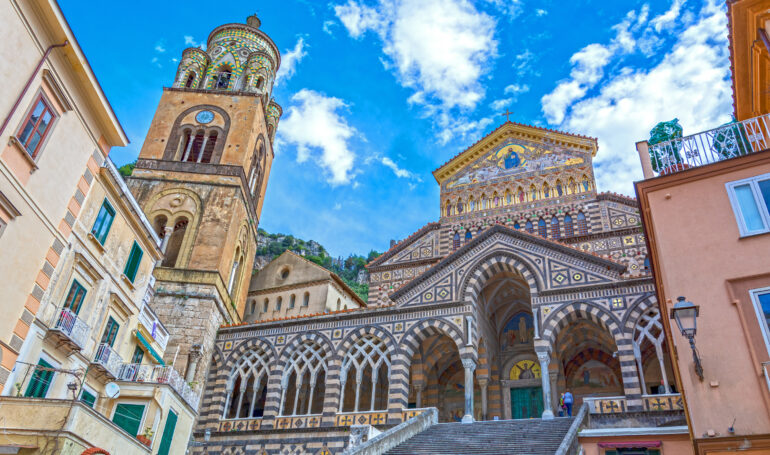
Italy’s Most Beautiful Churches
Undoubtedly it is a fact that Italy is a treasure trove of art, history, and culture. As a result, visiting a top museum in Italy might be on your list of activities. But let’s not forget that you will surely find art, history, and culture by visiting the many basilicas and cathedrals. Thus every year, millions of tourists visit Italy’s religious sights from all over the world. Although one needn’t even be religious to appreciate what Italy’s most beautiful churches offer.
In this post, I’ll be highlighting some must-visit churches to add for your next trip when visiting Italy. All these recommendations are based on my visits and my opinion of Italy’s most important churches, to me anyways. But beauty is in the eye of the beholder, and your list might be different than mine. But I hope I’ve given you some ideas for your next trip.
So from north to south, from monumental-sized structures to tiny churches, here is my list of favorites. This, however, is not an “all-inclusive” list. As this article would be thousands of words long if I were to list them all. Admittedly, in effect, my tours focus on food and wine, as you know. However, it seems that I can’t walk past a church and not go in it while in Italy.
So, without further ado, here’s my list, in no particular order.
Basilica di San Francesco d’Assisi, Assisi, Umbria
Surely if you read my previous blog post, you know this is a special place for me. Since 1230, the Basilica di San Francesco has housed the remains of the patron saint of Italy, St. Francis. A UNESCO World Heritage Site, the Saint himself indicated where he wanted to be buried when he passed. Although Francis recommended the construction of a very humble church, the sizable Basilica was built in his honor instead.
Firstly, the complex consists of two superimposed and independent churches. The upper Basilica, gothic and luminous, is famous worldwide for its thirteenth-century stained glass windows. The ceiling soars airily towards the sky. The wall surfaces are covered with frescoes depicting the Bible and recounting the life of St. Francis. The most influential painters of the time, including Cimabue, Giotto, and Cavallini, labored on this work. The humble lower Basilica, Romanesque and austere, almost has the function of supporting the one above. It is in the lower Basilica where pilgrims will find the relics of the Saint.
A unique atmosphere pervades the Basilica of St. Francis of Assisi. Perhaps because of this little-known fact: The Basilica stands on Colle dell’Inferno, or Hill of Death. Called so as it was where the outcasts were executed, and death sentences were carried out.
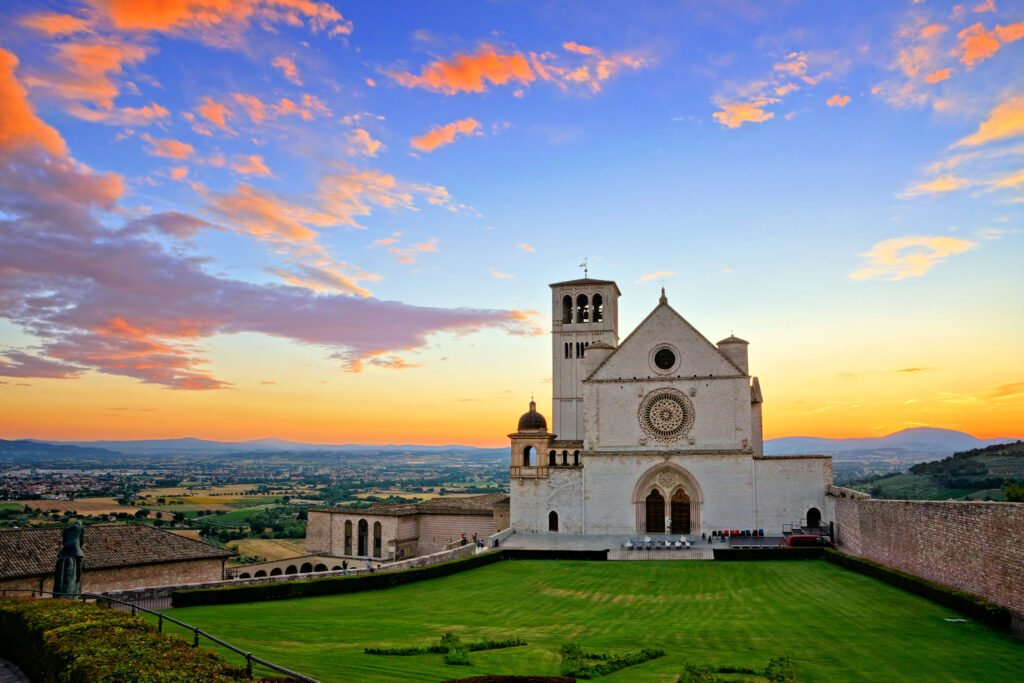
La Chiesa Madre di San Nicolò, Noto, Sicilia
In my previous blog post, you might have read about my love for Eastern Sicily. The Chiesa Madre di San Nicolò, also known as the Noto Basilica, had to be on my list. The Cathedral of Noto is the bishop’s seat of the Diocese of Noto. Completed in 1703, it was built in honor of San Nicolò, bishop of Myra. It is located at the top of a large staircase of eighteenth-century origin. It is a splendid example of the Sicilian Baroque architectural style.
Unfortunately, on March 13, 1996, the Cathedral of San Nicolò collapsed, and only the dome remained standing. In January 2000, the restoration work of the structural parts began. Leaving the restoration of the internal decorations to a later date. The repairs were a moment of great marriage between innovation and tradition. The works were carried out with the same materials and methods of the eighteenth century. However, correcting some minor errors that had probably caused the collapse. On June 18, 2007, the Cathedral finally reopened its doors to faithful tourists worldwide.
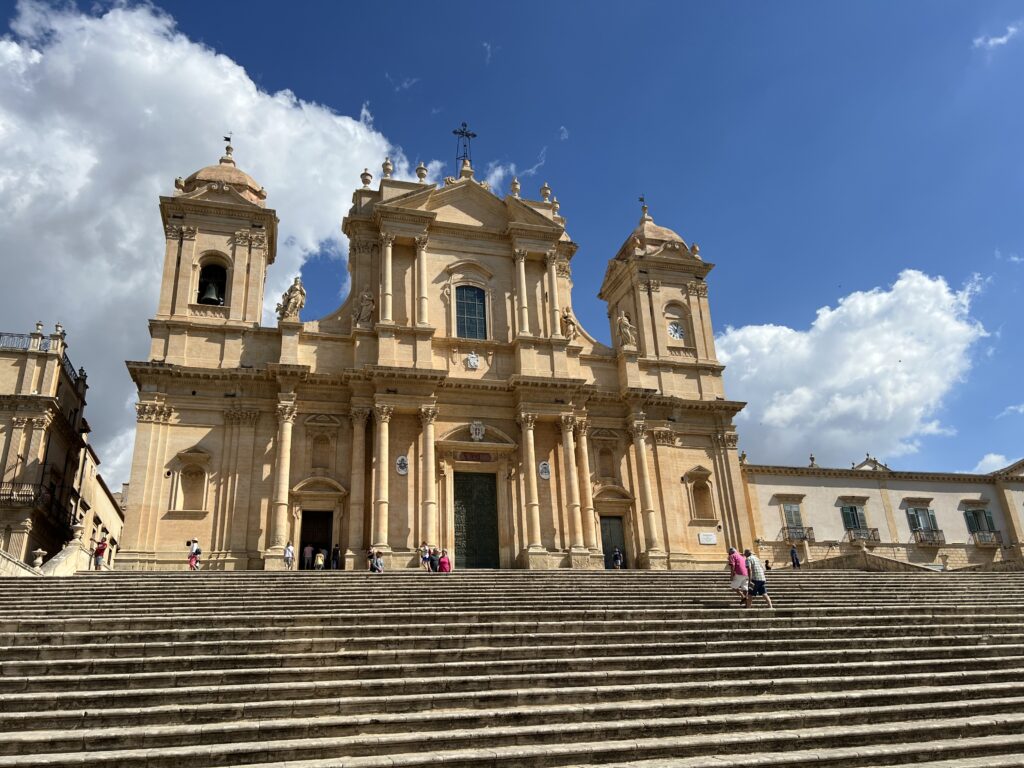
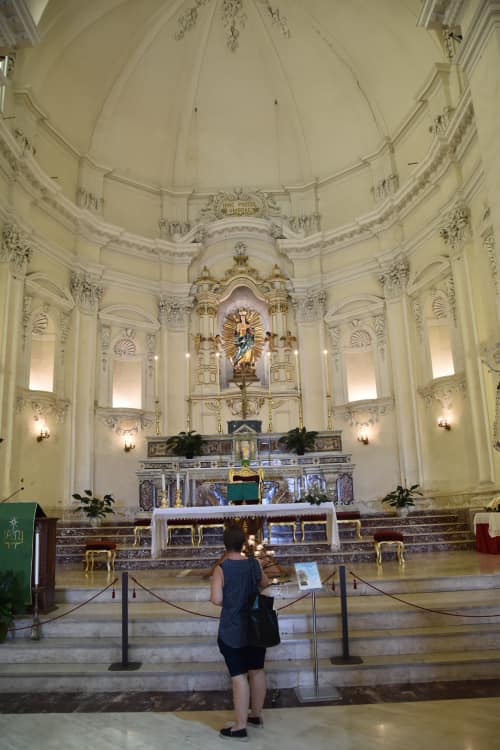
Picture credit: Walter Shaughnessy.
Cattedrale di Santa Maria del Fiore, Firenze, Toscana
The Cathedral of Santa Maria del Fiore, simply known as the Duomo, doesn’t need much introduction. This is undoubtedly one of the most famous churches in Italy and Europe. The famous Brunelleschi’s dome embellishes it. Construction began in 1296, and was completed in 1436. The Cathedral is the third largest Church in Europe. It is considered by many as among one of the ten most beautiful churches in Italy.
The duomo houses the most extensive surface ever decorated with frescoes, about 3600 square meters. Its masonry dome is the largest ever built. One of the cathedral’s most spectacular attractions is the visit to the terrace. From here, you’ll enjoy a fantastic panoramic view of Florence. You will also have the opportunity to look at the dome up close and observe the intricate work behind its creation in more detail.
The staircase leading up to the dome is narrow, twisted, and mysterious. There are 463 steps to the top, with graffiti left by previous tourists along the way. Please don’t be like these tourists and add to it. Be sure to purchase advance “skip the line” tickets if you plan on visiting yourself.
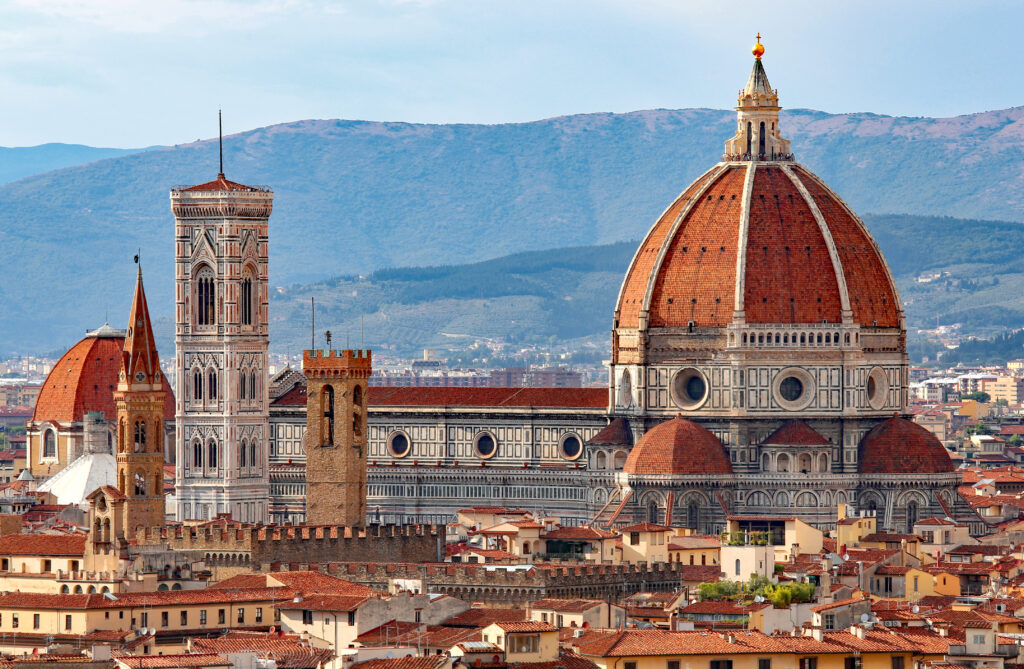
Duomo di Santa Maria Assunta, Siena, Toscana
The Duomo di Santa Maria Assunta, also known simply as the Duomo of Siena, is one of the most significant representations of the Italian Romanesque Gothic style. Of great artistic and cultural value, its internal structure is dominated by the two-tone black and white, in reference to the colors of the coat of arms of Siena. The floor, divided into 56 squares, is a unique work of Italian art due to the richness, creativity, vastness, and importance of the names that collaborated on it. The inlays show representations related to Revelation through Scripture, and over forty artists took part in it. Unfortunately, while some panels are permanently on display, but because of preservation, others are covered up and displayed at specific times during the year. If you are interested in a complete viewing, they are usually unveiled in July and September, but dates change every year, so check ahead.
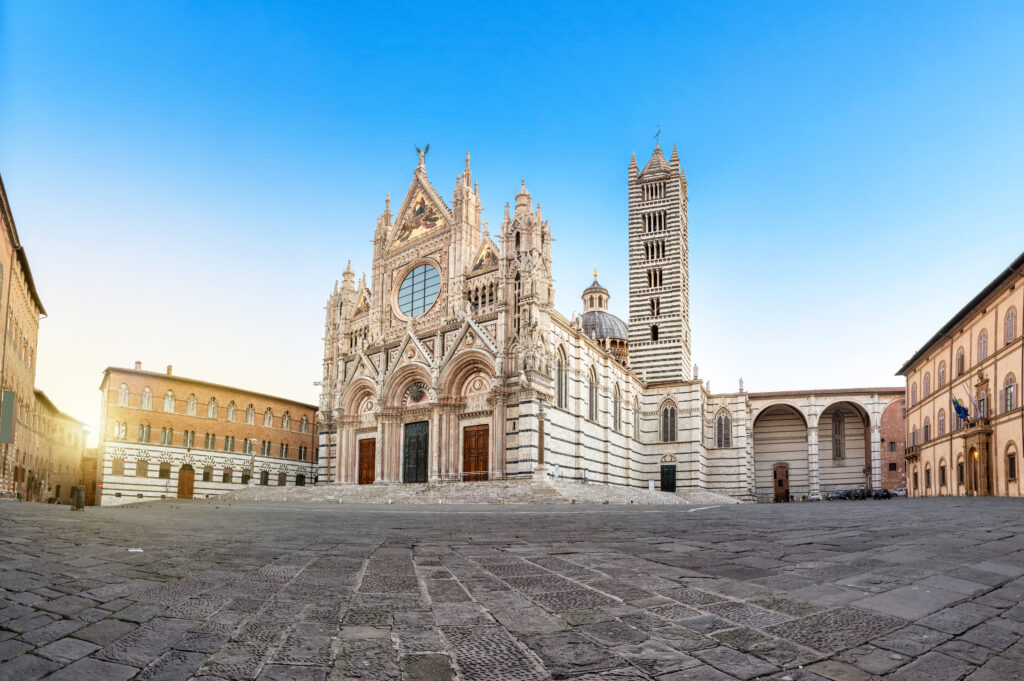
Basilica di San’ Antonio di Padova, Padova, Veneto
In this older blog post, I discuss the importance of visiting St. Anthony’s Basilica with my family. Like Assisi, this church will always hold a special place in my heart. Construction of the Basilica Di St. Antonio di Padova began in 1232 to guard the tomb of the Franciscan friar, Antonio, who died in Padova in 1231. It stands on land where another church dedicated to Mary existed, and was later incorporated inside the Basilica with the Chapel of the Black Madonna inside it. In 1229, a convent was built next to this ancient building, founded for the friars by St. Anthony.
You will find a harmonious mix of styles in this Basilica, such as Romanesque, Gothic, Byzantine, Renaissance, and Baroque. It is one of the largest churches in the world. The relics of Saint Anthony are kept here. It is one of the most revered shrines in the Christian world. You will also find thousands of notes of gratitude from past pilgrims left behind for the Saint.
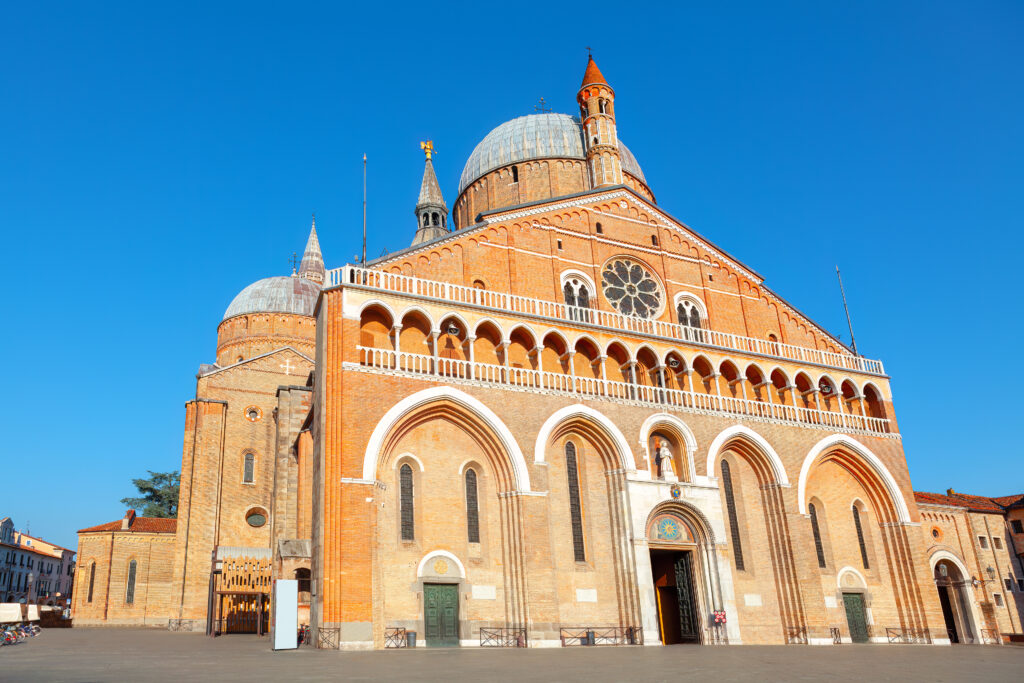
Cattedrale Metropolitana della Natività di Maria Santissima, Siracusa, Sicilia
Located in Piazza Duomo, one of my favorite, and most beautiful piazzas in Italy, is where you will find the Duomo of Syracuse. This is without a doubt one of the jewels of Sicily.
This majestic building stands on the elevated part of the island of Ortigia. Its Baroque façade, built between 1728 and 1754, is a mix of architectural styles, making it a fascinating spot to visit. In addition to the beautiful façade, considered today a true masterpiece of Baroque art, the Cathedral of Syracuse is characterized by its particular structure and splendid works of art, statues, and decorated chapels. You will find columns decorated with grape branches, a wooden roof, and marble floors that form the backdrop for complex marble statues of saints. The internal structure has three naves and several splendid attractions, such as stone columns, a silver statue of Saint Lucia, and a Byzantine-era crucifix. The statue of Saint Lucia is exposed only a few times a year, and I have had the privilege of being there for it several times.
A symbol of the city, the Duomo, has been part of the UNESCO World Heritage Sites since 2005. The Duomo houses statues, relics, and the remains of saints, martyrs, and Syracusan nobles. I love visiting the Duomo, then sitting in the impeccably clean piazza, at Café Condorelli, directly across the Duomo, enjoying a refreshing granita and waiting for the bells to toll.
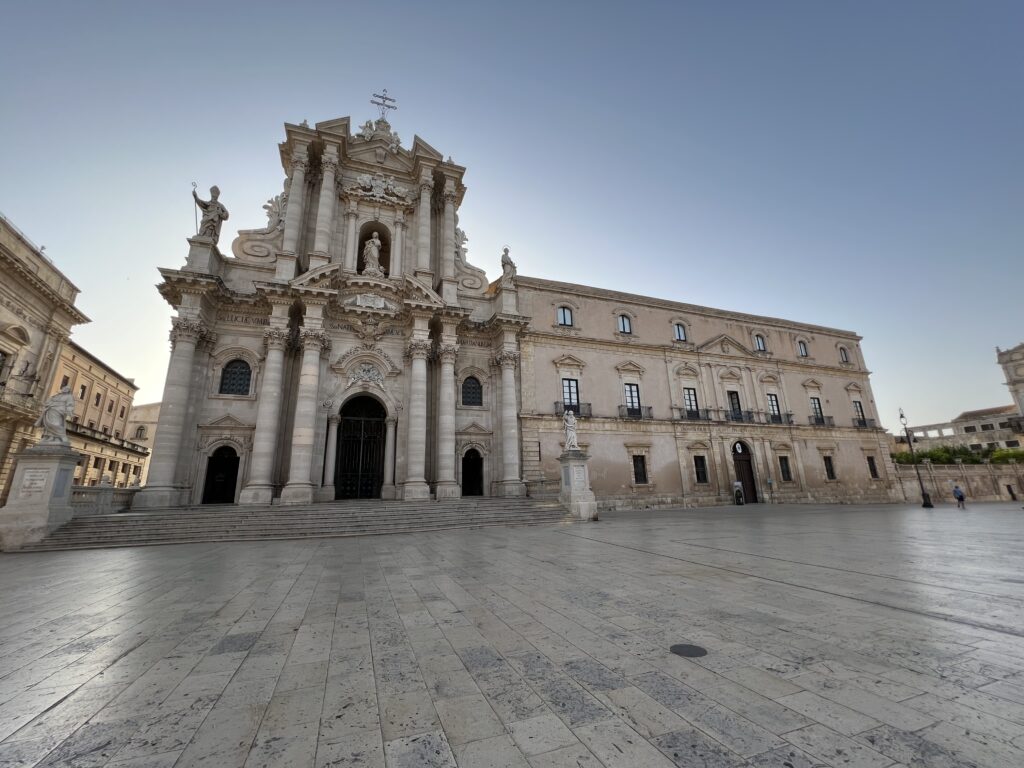
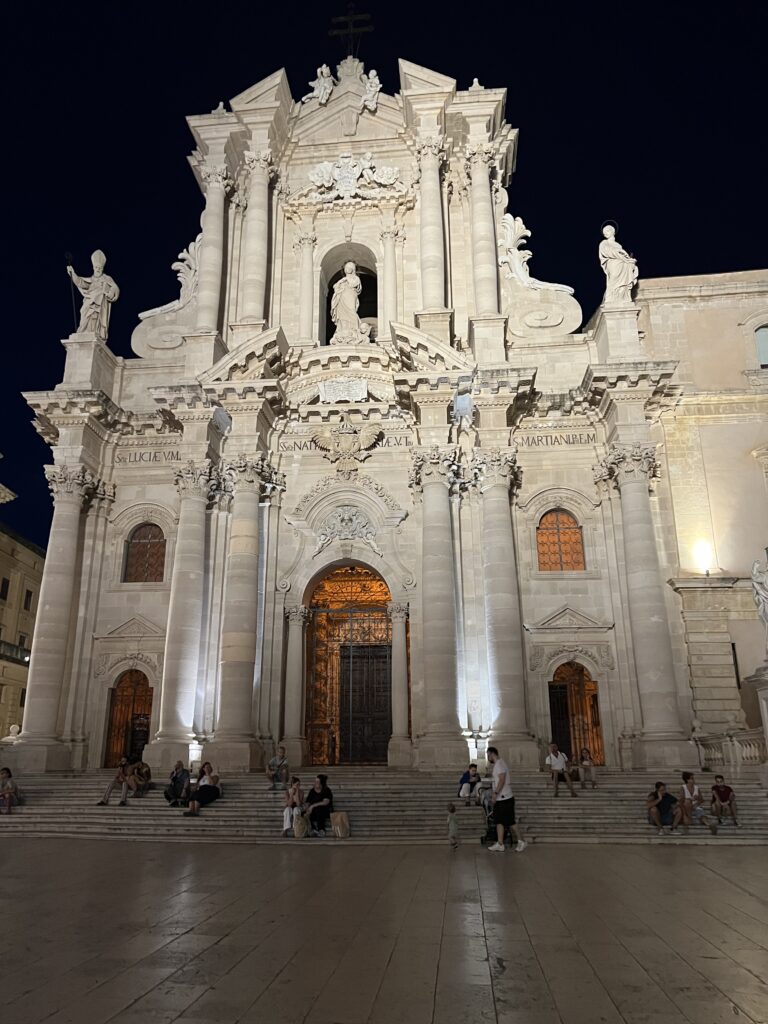
Basilica di Santa Croce, Lecce, Puglia
Considered the emblem of Lecce Baroque art, the Basilica of the Holy Cross is one of Lecce’s most important and admired churches and a real jewel in the Italian artistic panorama. Its extraordinary façade, precious works of art, and refined decorations make it an unmissable stop for anyone visiting the city of Lecce and the Salento region. The construction of this immense religious structure began in 1549 at the request of the Celestine fathers after the demolition of the ancient temple and monastery that stood there during the second half of the 1300s. Construction was completed 200 years later, in 1699, by Leccese architects Gabriele Riccardi, Francesco Antonio Zimbalo, and Cesare Penna.
The construction of the Basilica proceeded slowly due to the economic and political difficulties of the time. However, the Basilica underwent further modifications and restorations over the years, especially after the earthquake in 1743, which caused damage to the structure. Today, the Basilica of Santa Croce is considered one of the most important examples of Baroque architecture and one of the main places of interest when visiting Lecce. The Basilica continues to amaze and fascinate visitors and art lovers from all over the world.
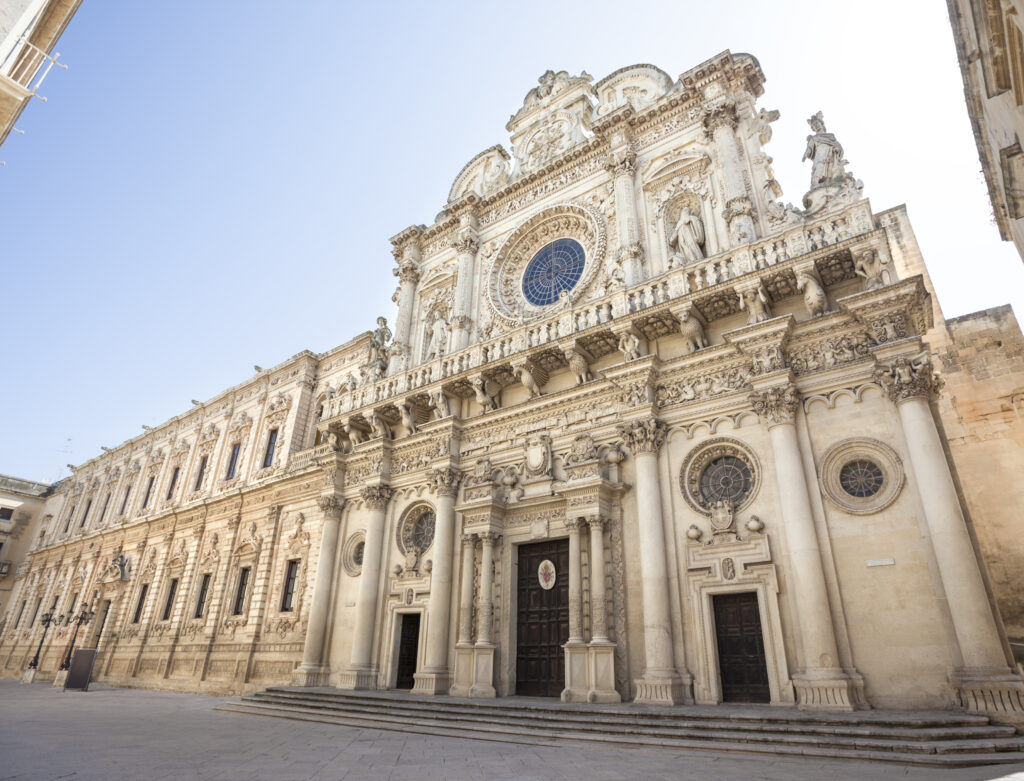
Cattedrale di Sant’Andrea, Amalfi, Campagnia
Known simply as the Duomo di Amalfi, this incredible church is one of the main attractions of Amalfi. Visited every year by thousands of tourists, it leaves the visitors enchanted by its grandeur. The Cathedral is one of the symbols of the town and the entire Amalfi Coast. Among one of Italy’s the most visited and photographed monuments, the Cathedral is striking for its particular façade. The spectacular staircase is made up of 62 steps.
The Duomo is named after Saint Andrea, the patron saint of Amalfi, who is celebrated twice yearly. The Duomo was built by Duke Mansone I in 987. This was amid the wealth and power of the Maritime Republic of Amalfi. The construction was carried out by adding the new Cathedral to a pre-existing one to build a new, more imposing, and larger one. The new church was built in Romanesque style, with a structure of six naves, three from the new church, and three from the pre-existing one. This strange practice was typical for the first churches of Byzantine-influenced cities. The presence of many naves made it possible to officiate several masses simultaneously, a common practice that remained in the Orthodox Church.
I love this church a great deal. When I find myself in Amalfi, it has become a favorite activity of mine to catch the Sunday service, then treat myself to a cappuccino and pastry and Pasticceria Pansa, located just a few short steps from the Duomo.
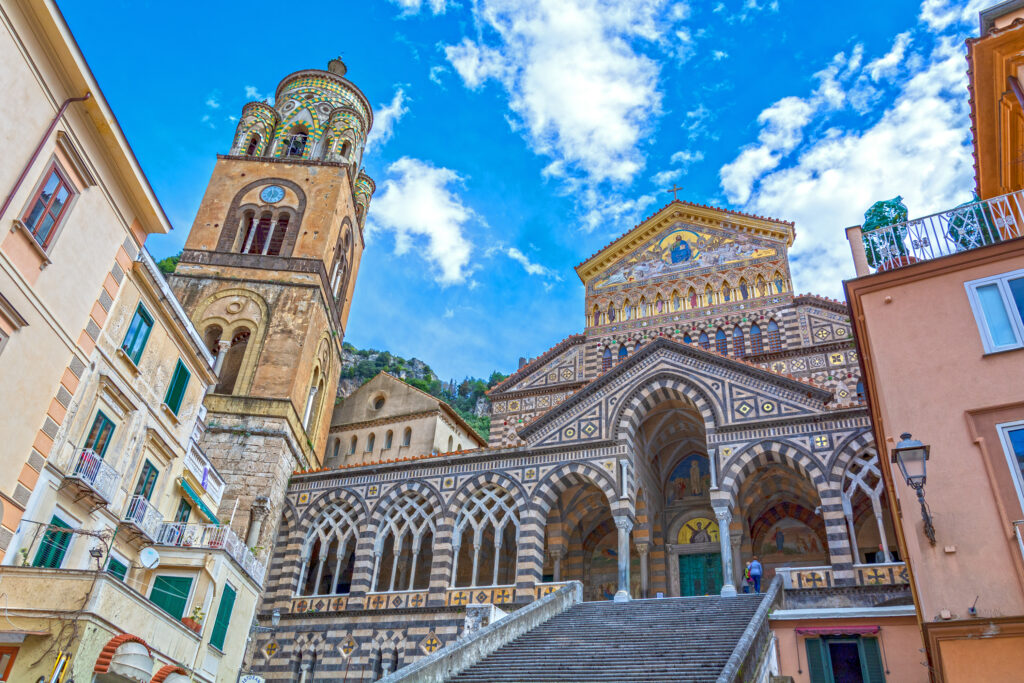
Basilica di San Marco, Venezia, Veneto
The Basilica of San Marco is one of the most significant symbols of Venetian art and Christianity. It is also known as “The Golden Church” thanks to the interior of this beautiful church, which is the envy of the whole world thanks to the golden mosaic decoration. The stupendous external façade has numerous arches decorated with beautiful mosaics; the “universal judgment” is depicted in the central lunette. You can also see the majestic bronze doors.
The interior consists of three naves separated by polychrome marble pillars and five domes, all covered with golden mosaics and magnificent frescoes. With its mosaic-covered domes and grand Italo-Byzantine architecture, it’s no wonder St. Mark’s Basilica is the focal point of St. Mark’s Square and the official Cathedral of Venice. Its interior boasts more than 80,000 square meters of gilded Byzantine mosaics, mostly dating from the 11th-13th centuries, which cover the vaulted ceiling and domes of the church.
But don’t forget to look down. The Basilica’s intricately patterned floor is a stunning mix of mosaics and marble arranged in a geometric design.
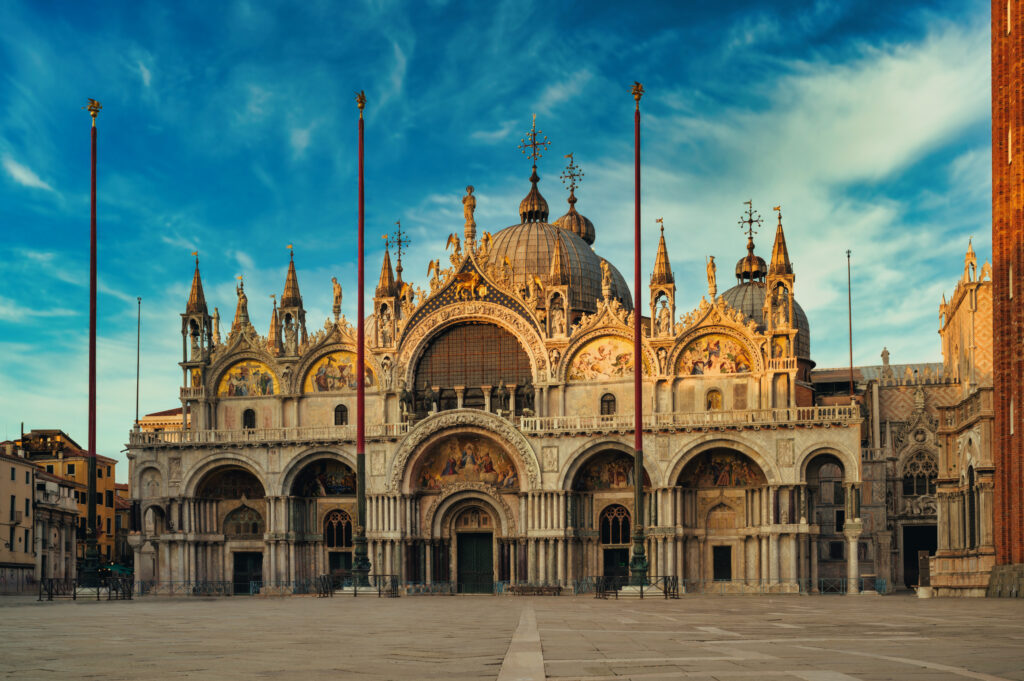
Chiesa Gesù Nuovo, Napoli, Campagnia
From the outside, it’s a simple, gray building. One element that distinguishes the Gesù Nuovo from all the other churches in Naples is its unmistakable, and unassuming external façade. The inside, however, is a different story. What is certain is that this church will leave you breathless with the beauty, history, and poetry it exudes.
Visiting the Church of Gesù Nuovo means getting to the heart of the history of Naples and its most beautiful masterpieces! The church, also known as the Trinità Maggiore, is one of the essential basilicas in Naples. Together with the Monastery of Santa Chiara and the Immaculate Conception, the Gesù Nuovo frames the square of the same name, one of the liveliest and most animated places in the historic center. This church is a true icon of Naples. The way it stands imposingly on the square and its landmark buildings doesn’t give the idea of the grandeur that you will find inside.
As in all eighteenth-century Neapolitan churches, the interiors are an explosion of colors and a masterpiece of marble and stucco. Almost all the most crucial marble workers, sculptors, and artists active in Naples between the 16th and 19th centuries have left their signatures on the marble and stucco coverings of the church. This is one church where words do not do it justice. It would be best if you simply visited for yourself.
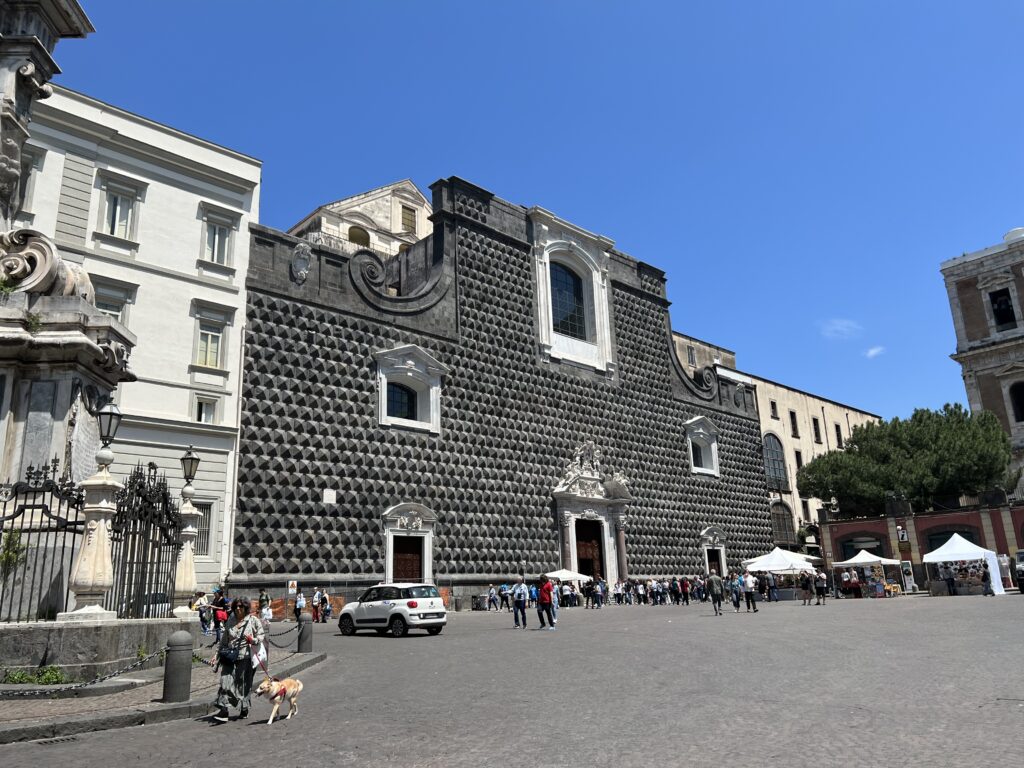
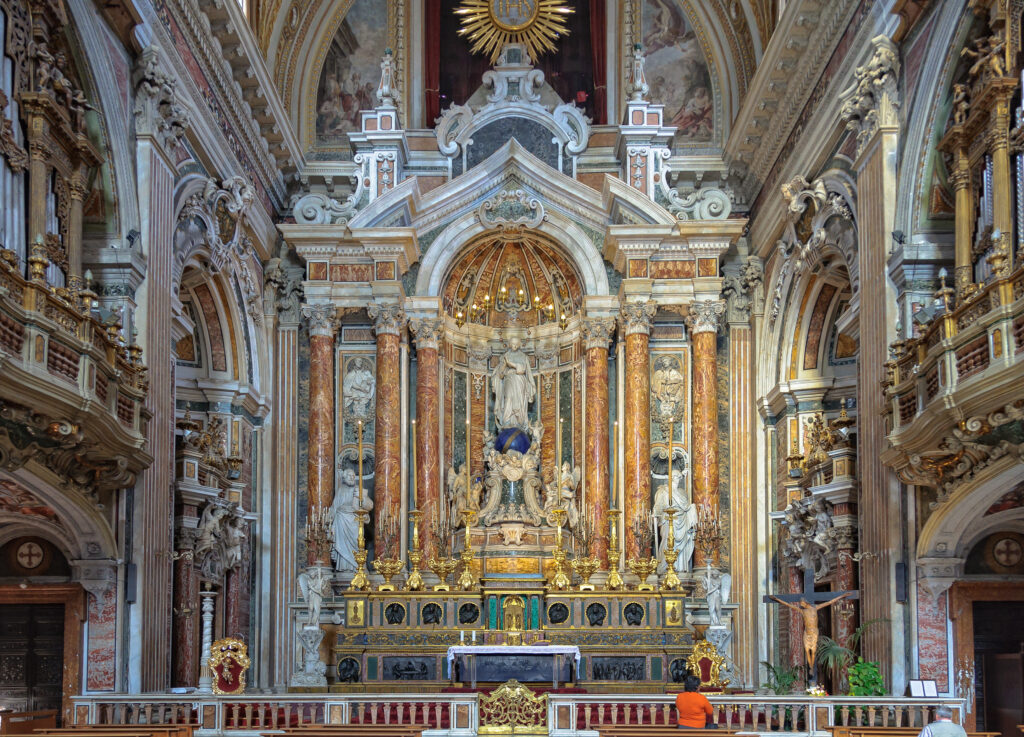
Picture credit: LICA.
Santuario della Madonna di San Luca, Bologna, Emilia Romagna
Located on Colle della Guardia, the Sanctuary of the Madonna of St. Luca is a destination of excellence for Bologna. The sanctuary can be reached by walking along the longest portico in the world, the work of Francesco Dotti. The portico is about two miles long, mostly uphill. You can, however, take the trolley (like I did) and save yourself some energy. Perhaps opt for the scenic route on the way down. Since 1433, the portico has been crossed yearly by the procession from the Sanctuary to The Basilica of San Petronio in Piazza Maggiore. The Byzantine icon is the Madonna and Child statue, kept in the high altar and attributed to the Evangelist Luca. The Church, built in the Baroque style, has an interior characterized by an elliptical plan on which a Greek cross is grafted.
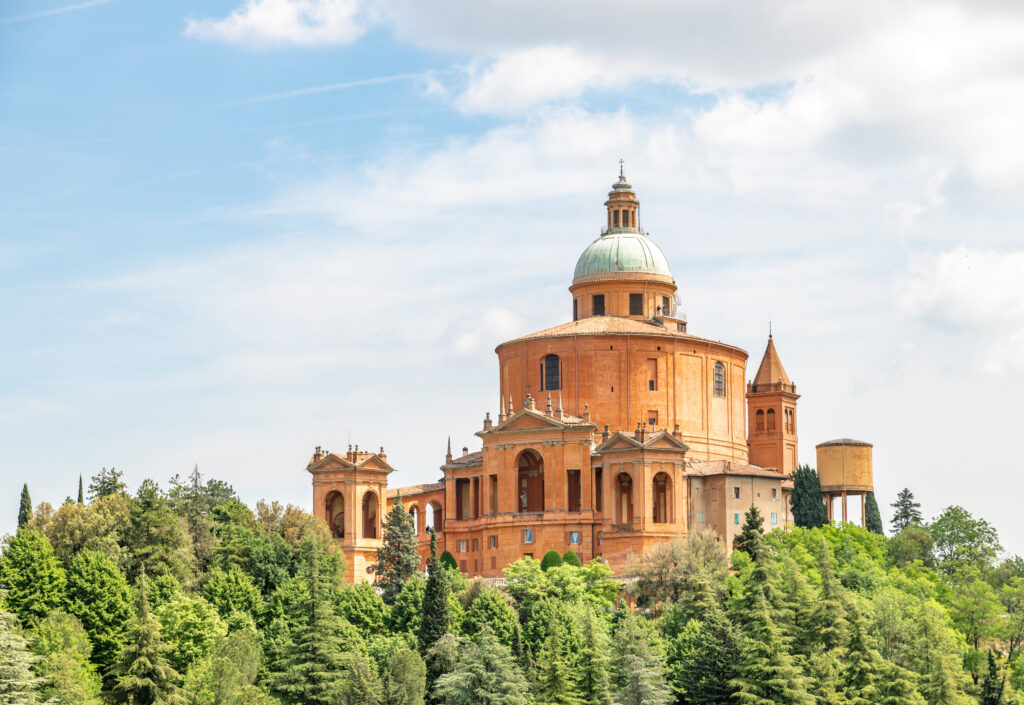
Chiesa di Santa Maria di Pietragrotta, Pizzo, Calabria
Located practically on the beach, the Church of Santa Maria of Pietragrotta is a gem to explore and visit. A can’t-miss destination for anyone visiting Pizzo in Calabria. Building began in the late 1600s and continued on by family members of the initial sculptors until the 1800s. This adorable seaside church pays homage to a painting of the Madonna. Legend says that the image was on a ship coming from Naples. There was a fierce storm during its travels, and the artwork and other objects fell overboard. Somehow it found its way to shore under a small natural cave. Subsequent storms kept removing the image from the cave, but miraculously, it always found its way back to the cave. This lead locals to believe that Mary had found her permanent home. Over the subsequent years, the cave was expanded to what you see in the pictures below.
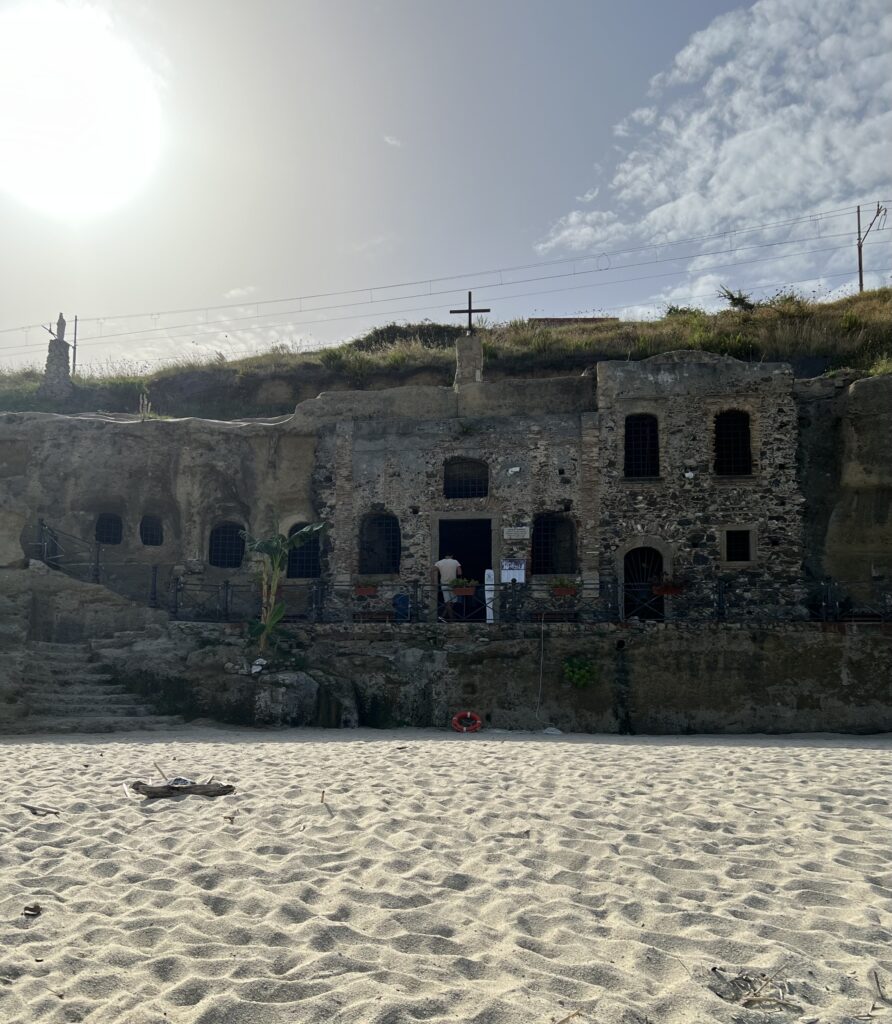
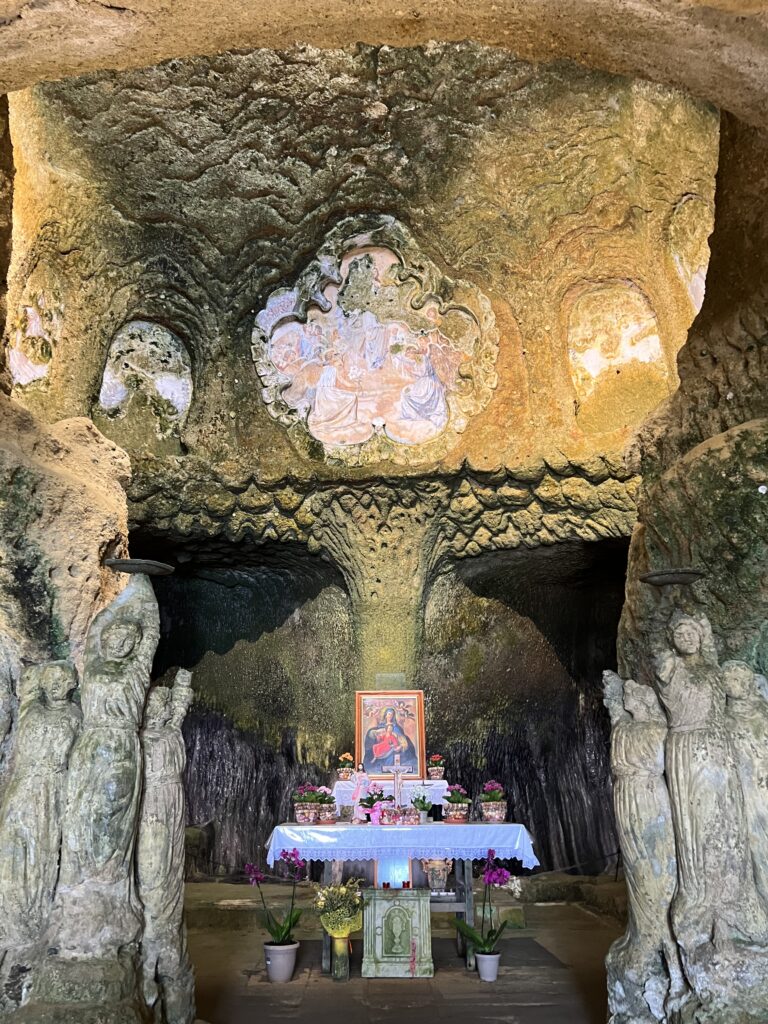
Santuario di Santa Maria dell’Isola, Tropea, Calabria
It’s hard to believe that you can find peace and quiet in the crowded town of Tropea in Calabria. Dominating the white beach is a massive rock overlooking the sea, on which stands the Sanctuary of Santa Maria dell’Isola, a place of faith that represents the symbol of the “pearl of the Tyrrhenian Sea.” This spectacular Basilica, much desired by the Benedictines, boasts a well-kept garden and a tiny but simple interior in which to escape the busy town for some calmness. Don’t be discouraged by the steps you must take to reach it. The view is well worth it. From here, you can see the Aeolian Islands on a clear day.
If you happen to be visiting on August 15, you can admire the procession on the water of the Madonna. Remember, this is one of Tropea’s busiest days, with tourists from near and far flocking to celebrate the holiday of Feragosto, Italy’s most significant summer holiday.
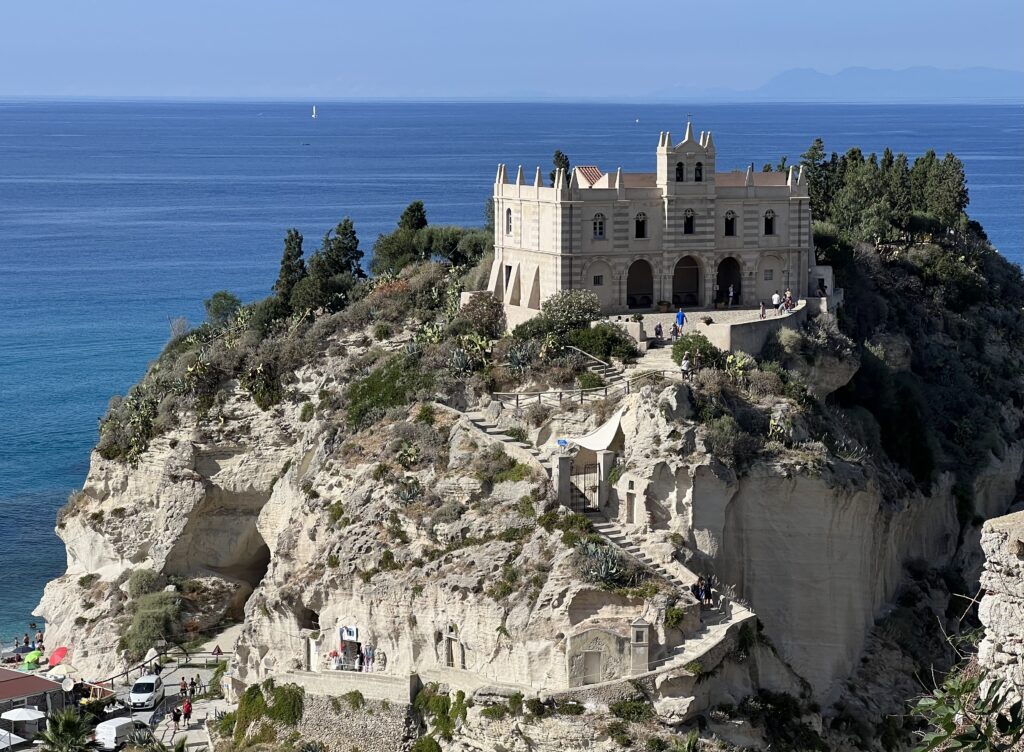
Chiesa Maria Santissima Immacolata, Scilla, Calabria
The Chiesa Maria Santissima Immacolata in Scilla is also a favorite of mine, which happens to be not far from where I come from in Calabria. The current building was built on a pre-existing church dedicated to Santa Maria Cattolica and part of the ancient Basilian convent of San Pancrazio. In the 16th century, it was severely damaged by earthquakes, so much so that it had to undergo profound renovations, which also led to an expansion of the structure. The church also suffered the same fate in the 18th century with an earthquake that brought down the entire central vault, and in 1908, the rear part and the internal colonnade on the west side were demolished.
Outside the church is a marble colonnade formed by six ionic columns, also present in the pre-existing buildings. The interior is divided into three naves. Behind the main altar, made with inlaid polychrome marble, there is a mosaic that covers the entire large wall and depicts an angel illuminated by the Holy Spirit with the houses of Scilla below. What is unique about the angel is that its gender is left up to your interpretation. In addition to several valuable paintings, the church houses a statue of the Immaculate Conception dating back to the seventeenth century and one depicting St. Peter the Apostle, attributed to the school of Bernini.
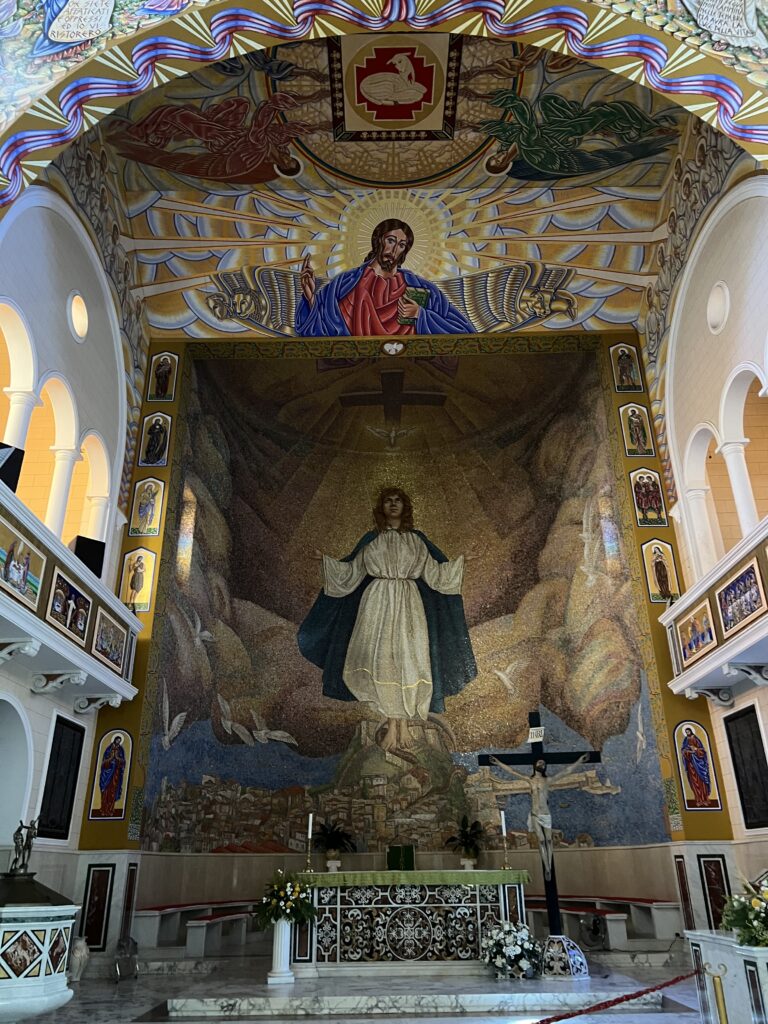
Chiesa di San Nicola Vescovo, Palermiti, Calabria
I would be remiss if I didn’t mention this small church in the small town of Palermiti in Calabria. You will not find the Church of San Nicola in any guidebook or any “best of” lists other than my own, but it is the church where I was Baptized and received my First Holy Communion and where my parents married. Like many of the other churches mentioned above, the original town church was completely destroyed by an earthquake in 1783 and subsequently rebuilt in another location. The church’s layout and structure are very similar to the contemporary churches of the area, built from scratch after the earthquake.
The church is dedicated to San Nicola, or St. Nicholas, but the patroness of this small town, and the church is the Madonna of the Light. Thousands gather to celebrate in grand style each year and pay homage to Her. Be sure to read more about this festival by clicking here.
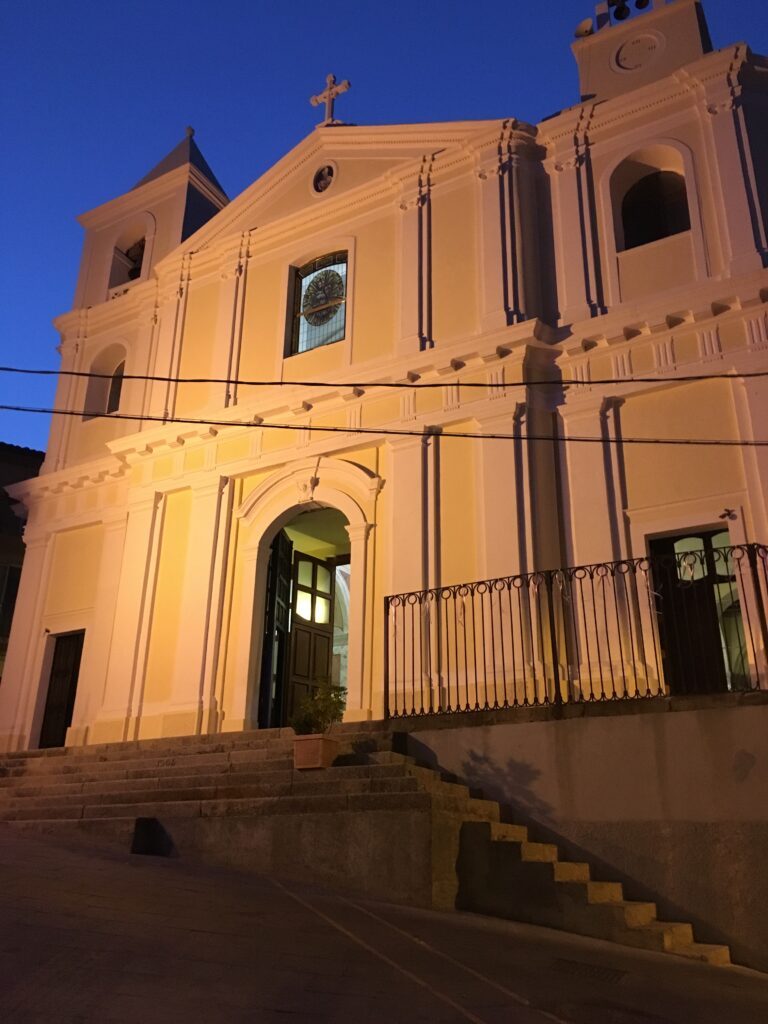
Others on my List
My list of churches that I have yet to visit and wish to see is long and extensive. I look forward to visiting them all. The partial list includes the Orvieto Cathedral, and the Sanctuary of the Madonna della Corona in Spiazzi. The Basilica of Superga in Turin, and the Sanctuary of Santa Maria and its Temple of Valadier in Genga are also on the list. The Basilica of Siponto in Manfredonia, the Church of Santa Margherita in Vernazza, the Matera Cathedral in Basilicata, the Duomo of Milan, and the immense Cathedral of Monreale, in Palermo are as well! Needless to say, I have a lot of traveling to do!
In Conclusion
I could go on and on about some of my other favorite churches I have visited in Italy. It seems that despite not being what I consider to be very religious, I can’t walk past a church and not enter it. Some of my other favorites that I have had the privilege of visiting include the San Giorgio Cathedral in Modica, Sicily, the Cathedral of St. Maria Matricolare in Verona, and the Cathedral in Otranto, with its creepy ossuary staring back at you. Again, one needn’t be religious, or Catholic to appreciate these amazing works of art and architecture. One just needs to be able to appreciate talent.

What to Pack for Italy
Cosa Mettere in Valigia per l'Italia
Everyone is always asking me what they should pack for Italy,
so I’ve created a quick reference guide that you can use for your next trip.
Hint: You don’t need nearly as much as you think you do!

Leave a Reply